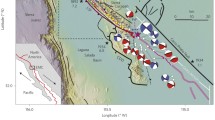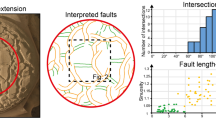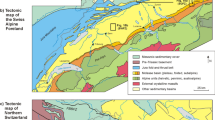Abstract
The aim of the present work is to study the influence of preexisting pervasive strength anisotropy on the development of faults during two phases of extensions. Two different series of experiments are performed by deforming rectangular three-layered models either by orthogonal extension followed by oblique extension (series 1) or by oblique extension followed by orthogonal extension (series 2). The model represents a rectangular zone of rifting. The final fault architecture after two successive phases of extension is primarily controlled by the orientation of the pervasive strength anisotropy. The mode of far-field stress (orthogonal or oblique) plays a role in fault initiation during both the phases of extension. The growth of the faults which are orthogonal or oriented more obliquely (β = 45°/60°) with respect to the rift normal is controlled by the direction of extension. However, the less oblique faults (β = 15°) develop as strike-slip faults irrespective of the direction of extension. The phase 1 faults reactivate during the phase 2 extension only when they are parallel to the preexisting pervasive anisotropy. New faults parallel to the rift axis form only if the phase 2 extension is orthogonal (series 2). It is found to happen irrespective of the orientation of the strength anisotropy and of the 1st phase faults. Those faults act as linking faults for the highly oblique (β = 45°/60°) phase 1 faults. New faults are formed following the anisotropy during both orthogonal and oblique phase 2 extension only if the anisotropy is oriented at low angle (β = 15°) with the rift normal. The different fault patterns developed in the experiments can be matched well with natural examples reported from Karonga basin, Malawi rift, Kenya.

















Similar content being viewed by others
References
Acocella V, Faccenna C, Funiciello R, Rossetti F (1999) Sand-box modelling of basement-controlled transfer zones in extensional domains. Terra Nova-Oxford 11(4):149–156
Agostini A, Bonini M, Corti G, Sani F, Mazzarini F (2011) Fault architecture in the Main Ethiopian Rift and comparison with experimental models: Implicationsfor rift evolution and Nubia-Somalia Kinematics. Earth and Planetary Science Letters 301:479–492. https://doi.org/10.1016/j.epsl.2010.11.024
Ammann N, Liao J, Gerya T, Ball P (2018) Oblique continental rifting and long transform fault formation based on 3D thermomechanical numerical modeling. Tectonophysics 746:106–120. https://doi.org/10.1016/j.tecto.2017.08.015
An L-J, Sammis CG (1996) Development of strike-slip faults: shear experiments in granular materials and clay using a new technique. Journal of Structural Geology 18:1061–1077. https://doi.org/10.1016/0191-8141(96)00012-0
Bellahsen N, Daniel JM (2005) Fault reactivation control on normal fault growth: An experimental study. Journal of Structural Geology 27:769–780. https://doi.org/10.1016/j.jsg.2004.12.003
Bellahsen N, Fournier M, d'Acremont E, Leroy S, Daniel JM (2006) Fault reactivation and rift localization: northeastern Gulf of Aden margin. Tectonics 25(1). https://doi.org/10.1029/2004TC001626
Berenbaum R, Brodie I (1959) Measurement of the tensile strength of brittle materials. British Journal of Applied Physics 10:281–287. https://doi.org/10.1088/0508-3443/10/6/307
Bonini M, Thierry Souriot MB, JPB (1997) Successive orthogonal and oblique extension episodes in a rift zone: laboratory experiments with application to the Ethiopian Rift. Tectonics 16:347–362. https://doi.org/10.1029/96TC03935
Brune S (2016) Rifts and rifted margins: a review of geodynamic processes and natural hazards. Plate Boundaries and Natural Hazards 219:13. https://doi.org/10.1002/9781119054146.ch2
Chakraborty C, Kumar S, Chakraborty G and T (2003) Depositional record of tidal-flat sedimentation in the Permian coal measures of Central India: Barakar formation, Mohpani Coalfield, Satpura Gondwana Basin. Gondwana Research 6:817–827. doi: https://doi.org/10.1016/S1342-937X(05)71027-3
Chattopadhyay A, Chakra M (2013) Influence of pre-existing pervasive fabrics on fault patterns during orthogonal and oblique rifting: An experimental approach. Marine and Petroleum Geology 39:74–91. https://doi.org/10.1016/j.marpetgeo.2012.09.009
Chattopadhyay A, Mandal N (2002) Progressive changes in strain patterns and fold styles in a deforming ductile orogenic wedge: an experimental study. Journal of Geodynamics 33:353–376. https://doi.org/10.1016/S0264-3707(01)00079-5
Chattopadhyay A, Jain M, Bhattacharjee D (2014) Three-dimensional geometry of thrust surfaces and the origin of sinuous thrust traces in orogenic belts: insights from scaled sandbox experiments. Journal of Structural Geology 69:122–137. https://doi.org/10.1016/J.JSG.2014.09.020
Clifton AE, Schlische RW (2001) Nucleation, growth, and linkage of faults in oblique rift zones: results from experimental clay models and implications for maximum fault size. Geology 29(5):455–458. https://doi.org/10.1130/0091-7613(2001)029<0455:NGALOF>2.0.CO;2
Clifton AE, Schlische RW, Withjack MO, Ackermann RV (2000) Influence of rift obliquity on fault-population systematics: results of experimental clay models. Journal of Structural Geology 22:1491–1509. https://doi.org/10.1016/S0191-8141(00)00043-2
Corti G (2004) Centrifuge modelling of the influence of crustal fabrics on the development of transfer zones: insights into the mechanics of continental rifting architecture. Tectonophysics 384:191–208. https://doi.org/10.1016/J.TECTO.2004.03.014
Corti G, Bonini M, Innocenti F et al (2001) Centrifuge models simulating magma emplacement during oblique rifting. Journal of Geodynamics 31(5):557–576. https://doi.org/10.1016/S0264-3707(01)00032-1
Corti G, van Wijk J, Cloetingh S, Morley CK (2007) Tectonic inheritance and continental rift architecture: numerical and analogue models of the East African Rift system. Tectonics 26:1–13. https://doi.org/10.1029/2006TC002086
Cotton JT, Koyi HA (2000) Modeling of thrust fronts above ductile and frictional detachments: application to structures in the Salt Range and Potwar Plateau, Pakistan. Geol. Soc. Am. Bull 112(3):351–363
Daly MC, Chorowicz J, Fairhead JD (1989) Rift basin evolution in Africa: the influence of reactivated steep basement shear zones. Geological Society, London, Special Publications 44(1):309–334. https://doi.org/10.1144/GSL.SP.1989.044.01.17
Dauteuil O, Brun J-P (1993) Oblique rifting in a slow-spreading ridge. Nature 361:145–148. https://doi.org/10.1038/361145a0
Davy P, Cobbold PR (1988) Indentation tectonics in nature and experiment. 1. Experiments scaled for gravity. Bull. Geol. Inst. Univ. Uppsala 14:129–141
Deng C, Gawthorpe RL, Fossen H, Finch E (2018) How does the orientation of a preexisting basement weakness influence fault development during renewed rifting? Insights from three-dimensional discrete element modeling. Tectonics 37(7):2221–2242. https://doi.org/10.1029/2017TC004776
Dubois A, Odonne F, Massonnat G et al (2002) Analogue modelling of fault reactivation: tectonic inversion and oblique remobilisation of grabens. Journal of Structural Geology 24:1741–1752. https://doi.org/10.1016/S0191-8141(01)00129-8
Fournier M, Petit C (2007) Oblique rifting at oceanic ridges: relationship between spreading and stretching directions from earthquake focal mechanisms. Journal of Structural Geology 29(2):201–208. https://doi.org/10.1016/j.jsg.2006.07.017
Ghosh N, Chakra M, Chattopadhyay A (2014) An experimental approach to strain pattern and folding in unconfined and/or partitioned transpressional deformation. International Journal of Earth Sciences 103:349–365. https://doi.org/10.1007/s00531-013-0951-z
Ghosh N, Hatui K, Chattopadhyay A (2019) Propagation and coalescence of en-echelon cracks under a far-field tensile stress regime: An experimental study. Journal of Earth System Science 128:1–16. https://doi.org/10.1007/s12040-018-1056-7
Henza AA, Withjack MO, Schlische RW (2011) How do the properties of a pre-existing normal-fault population influence fault development during a subsequent phase of extension? Journal of Structural Geology 33:1312–1324. https://doi.org/10.1016/j.jsg.2011.06.010
Hetzel R, Strecker MR (1994) Late Mozambique Belt structures in western Kenya and their influence on the evolution of the Cenozoic Kenya Rift. Journal of Structural Geology 16:189–201. https://doi.org/10.1016/0191-8141(94)90104-X
Hubbert MK (1937) Theory of scale models as applied to the study of geologic structures. Bulletin Geological Society of America 48(10):1459–1520
Hus R, Acocella V, Funiciello R, De Batist M (2005) Sandbox models of relay ramp structure and evolution. Journal of Structural Geology 27(3):459–473. https://doi.org/10.1016/j.jsg.2004.09.004
Jaeger JC (1969) Elasticity, fracture and flow with engineering and geological applications. Methuen & Co. Ltd, and Science Paperbacks, John Wiley & Sons, Inc., New York
Keep M, McClay KR (1997) Analogue modelling of multiphase rift systems. Tectonophysics 273:239–270. https://doi.org/10.1016/S0040-1951(96)00272-7
Kolawole F, Atekwana EA, Laó-Dávila DA, Abdelsalam MG, Chindandali PR, Salima J, Kalindekafe L (2018) Active deformation of Malawi rift's north basin hinge zone modulated by reactivation of preexisting Precambrian shear zone fabric. Tectonics 37(3):683–704. https://doi.org/10.1002/2017TC004628
Mandal N (1995) Mode of development of sigmoidal en echelon fractures. Proc. Indian Acad. of Sci-Earth and Planet. Sci. 104(3):453–464. https://doi.org/10.1007/BF02843409
Mauduit T, Dauteuil O (1996) Small-scale models of oceanic transform zones. Journal of Geophysical Research - Solid Earth 101:20195–20209. https://doi.org/10.1029/96JB01509
McClay KR, White MJ (1995) Analogue modelling of orthogonal and oblique rifting. Marine and Petroleum Geology 12:137–151. https://doi.org/10.1016/0264-8172(95)92835-K
McConnell RB (1972) Geological development of the rift system of eastern Africa. GSA Bulletin 83:2549–2572. https://doi.org/10.1130/0016-7606(1972)83[2549:GDOTRS]2.0.CO;2
Morley CK (1999) How successful are analogue models in addressing the influence of pre-existing fabrics on rift structure? Journal of Structural Geology 21:1267–1274. https://doi.org/10.1016/S0191-8141(99)00075-9
Morley CK, Haranya C, Phoosongsee W et al (2004) Activation of rift oblique and rift parallel pre-existing fabrics during extension and their effect on deformation style: examples from the rifts of Thailand. Journal of Structural Geology 26:1803–1829. https://doi.org/10.1016/j.jsg.2004.02.014
Nott JA (2009) Tensile strength and failure criterion of analog lithophysal rock. https://digitalscholarship.unlv.edu/thesesdissertations/116
Peace A, Mccaffrey K, Imber J et al (2017) The role of pre-existing structures during rifting , continental breakup and transform system development , offshoreWest Greenland. Basin Research 30:373–394. https://doi.org/10.1111/bre.12257
Peace A, Dempsey E, Schiffer C et al (2018) Evidence for basement reactivation during the opening of the Labrador Sea from the Makkovik Province, Labrador, Canada: insights from field data and numerical models. Geosciences 8(8):308. https://doi.org/10.3390/geosciences8080308
Philippon M, Willingshofer E, Sokoutis D, Corti G, Sani F, Bonini M, Cloetingh S (2015) Slip re-orientation in oblique rifts. Geology 43(2):147–150. https://doi.org/10.1130/G36208.1
Ramberg H (1975) Particle paths, displacements and progressive strain applicable to rocks. Tectonophysics 28:1–37. https://doi.org/10.1016/0040-1951(75)90058-X
Ring U (1994) The influence of preexisting structure on the evolution of the Cenozoic Malawi rift (East African rift system). Tectonics 13:313–326. https://doi.org/10.1029/93TC03188
Schön JH (2011) Rocks—their classification and general properties. In Handbook of Petroleum Exploration and Production. Elsevier 8:1–16. https://doi.org/10.1016/S1567-8032(11)08001-3
Serra S, Nelson RA (1988) Clay modeling of rift asymmetry and associated structures. Tectonophysics 153:307–312. https://doi.org/10.1016/0040-1951(88)90023-6
Teyssier C, Tikoff B, Markley M (1995) Oblique plate motion and continental tectonics. Geology 23(5):447–450
Theunissen K, Klerkx J, Melnikov A, Mruma AH (1996) Mechanisms of inheritance of rift faulting in the western branch of the East African Rift, Tanzania. Tectonics 15:776–790. https://doi.org/10.1029/95TC03685
Thomas AL, Pollard DD (1993) The geometry of echelon fractures in rock: implications from laboratory and numerical experiments. Journal of Structural Geology 15:323–334. https://doi.org/10.1016/0191-8141(93)90129-X
Tron V, Brun JP (1991) Experiments on oblique rifting in brittle-ductile systems. Tectonophysics 188:71–84. https://doi.org/10.1016/0040-1951(91)90315-J
Vekinis G, Ashby MF, Beaumont PWR (1993) Plaster of Paris as a model material for brittle porous solids. Journal of Materials Science 28(12):3221–3227
Wilson RW, Holdsworth RE, Wild LE et al (2010) Basement-influenced rifting and basin development: a reappraisal of post-Caledonian faulting patterns from the North Coast Transfer Zone, Scotland. Geol Soc London, Spec Publ 335:795–LP-826. https://doi.org/10.1144/SP335.32
Withjack MO, Jamison WR (1986) Deformation produced by oblique rifting. Tectonophysics 126:99–124. https://doi.org/10.1016/0040-1951(86)90222-2
Zwaan F, Schreurs G (2017) How oblique extension and structural inheritance influence rift segment interaction: insights from 4D analog models. Interpretation 5:SD119–SD138. https://doi.org/10.1190/INT-2016-0063.1
Zwaan F, Schreurs G, Buiter S (2019) 4D X-ray CT data and surface view videos of a systematic comparison of experimental set-ups for modelling extensional tectonics. https://doi.org/10.5880/fidgeo.2019.018
Acknowledgements
The working space was provided by Department of Geology, University of Delhi. The authors are thankful to Ms. Pooja Yadav, Mr. Supratik Ray and Ms. Nivedita Raina for their sincere help during the experiments. They are also thankful to Dr. Frank Zwaan and two anonymous reviewers for guiding them to improve the manuscript.
Funding
This work is financially supported by the Department of Science and Technology, Government of India (DST project no. SR/WOS-A/ES-26/2013, sanctioned to N. Ghosh).
Author information
Authors and Affiliations
Corresponding author
Additional information
Publisher’s note
Springer Nature remains neutral with regard to jurisdictional claims in published maps and institutional affiliations.
Appendix
Appendix
Scaling of viscous material (pitch)
A model is well scaled to their natural analogues, when the model and its natural prototype remain geometrically, kinematically and dynamically similar (Hubbert 1937; Ramberg 1975). To achieve scaling condition, the model material has to be very weak as experiments are run on real time which is much faster than geological deformations. Geometrical similarity is represented by the model ratio of length (length of the model/length of equivalent natural prototype). For our setup, model ratio of length (λ) = lm/ln = 0.2 × 10−5 (calculation shown in the Table 4). Kinematic similarity is represented by the model ratio of time (τ). Time ratio is calculated as the ratio of time needed for achieving a certain amount of deformation in the experiment and time needed to achieve the same amount of strain in the corresponding natural situation (Hubbert 1937, p1467). For our setup, model ratio of time (τ) = tm/tn = 3.8 × 10−11 (calculation is shown in the Table 4). Hubbert (1937) suggested that in case of very slowly moving viscous models, the forces due to inertia can be neglected without causing significant error. Consequently, dynamic similarity can be achieved if model ratios of length (l), mass (m), and time (t) are chosen arbitrarily and forces, viz. stress, pressure, shear strength, and viscosity are made to conform to the ratio μ = δλ3, where μ, δ, and λ are model ratios of mass, density and length, respectively (Hubbert 1937, p. 1489). In the present case, we have used viscous models (pitch) under slow strain rate (≈ 10−4/s). Therefore, we have assumed negligible inertial forces following Hubbert’s argument. When we compare the model viscosity ratio calculated from the fundamental model ratios (ζ = δλτ = 0.34 × 10−16) with the actual model ratio of viscosity found in model and its natural analogue (e.g., ξ = 0.51 × 10−16), they are found to be within the same order of magnitude (Table 4). Thus, our models achieve dynamic scaling at least approximately, and the results of our experiments can be reasonably extrapolated to natural situations.
Rights and permissions
About this article
Cite this article
Ghosh, N., Hatui, K. & Chattopadhyay, A. Evolution of fault patterns within a zone of pre-existing pervasive anisotropy during two successive phases of extensions: an experimental study. Geo-Mar Lett 40, 53–74 (2020). https://doi.org/10.1007/s00367-019-00627-6
Received:
Accepted:
Published:
Issue Date:
DOI: https://doi.org/10.1007/s00367-019-00627-6




